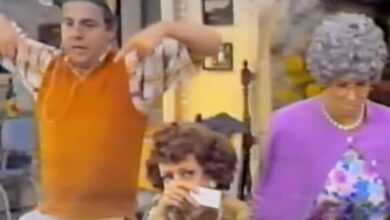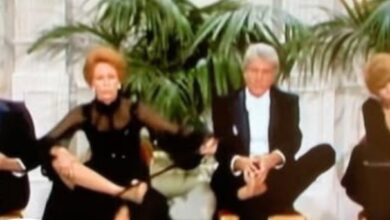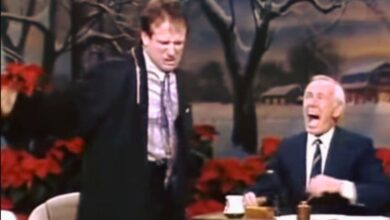Erik Grönwall’s “O Holy Night”: A Breathtaking Christmas Rendition Blending Faith, Resilience, and Rock Intensity into Timeless Brilliance
The release appeared like a celestial gift dropped into the holiday season: Erik Grönwall, the Swedish vocal powerhouse who first captured national attention by winning Idol in 2009 and later commanded stages with H.E.A.T and Skid Row, unveiled a moving, reverent take on “O Holy Night.” Filmed in the glow of candlelight within a church, it wasn’t a standard Christmas cover but an emotional declaration of resilience and faith. Known for electric performances, he transformed raw rock intensity into spiritual stillness, each lyric radiating quiet strength and gratitude.
While many discovered it in late 2024, loyal followers had been anticipating something extraordinary. A teaser revealed the release date—Friday, December 13 at 5 p.m. CET—recorded with the blessing of Alunda Församling, the parish that opened its sacred space for him. The setting alone spoke volumes: no heavy production, no synthetic effects, just natural acoustics and the warmth of flickering light. When the premiere arrived, the opening shot of candles against shadow framed his voice like a beacon piercing the still winter air.
The performance begins with stillness—a whisper that carries reverence rather than showmanship. Each phrase is delivered like a prayer, with breaths measured and deliberate. Slowly, layers of sound unfold: piano, then orchestral resonance, building tension toward a soaring conclusion. The dynamic progression feels organic, the crescendo earned through patience. Every high note blooms with precision, his rock-forged control reshaped into devotion. The result is both technical mastery and emotional honesty, a blend few artists ever achieve.
The deeper meaning behind the performance amplifies its emotional gravity. After being diagnosed with leukemia in 2021, Grönwall endured a bone marrow transplant and emerged triumphant. His comeback became a symbol of strength across the rock community. Having stepped away from Skid Row in 2024 to focus on health and family, he channeled his restored spirit into this performance. “O Holy Night” became more than a song—it was his testament, a hymn of gratitude sung by someone who had truly faced the dark and found light again.
The visual simplicity deepens that message. The video features no effects, no glimmering overlays—only candlelight, wood, and stone. The camera lingers instead of cutting, giving the viewer time to feel each emotion as it unfolds. When he reaches the climactic verse, the lens draws near, capturing his steady gaze and glint of moisture in his eyes. Every frame feels sincere, as if the camera itself has stopped breathing. The result is raw, grounded artistry—humility turned into cinematic reverence.
Almost immediately, the performance began spreading with unstoppable momentum. Within days, it drew hundreds of thousands of views, and the numbers continued to climb. It wasn’t viral by marketing—it was viral by emotion. Fans shared it across timelines as if passing along a blessing. Grönwall later noted that it surpassed 100,000 daily views and confirmed that it would soon reach all streaming platforms. The world wasn’t just watching; it was connecting to the faith embedded in his sound.
Its beauty lies in balance—strength entwined with serenity. His rock instincts give the hymn backbone, but never overpower its spirit. The spaces between words become as meaningful as the notes themselves, and silence becomes a form of music. When he finally releases his full range, it feels less like display and more like surrender. The arrangement itself mirrors the soul’s journey—from humility to transcendence—carving a cinematic arc from whisper to exultation that leaves audiences breathless.
Audience reactions were instant and heartfelt. Vocal experts praised his control and effortless execution, dissecting how he sustained high notes with clarity and calm. Rock fans admired the raw grit behind the refinement, while spiritual listeners felt moved by its purity. Comment sections filled with confessions of goosebumps, tears, and awe. It was rare unanimity online—an agreement that what they had witnessed transcended genre or generation. This wasn’t just performance; it was communion through song.
The sacred setting enhances the atmosphere immeasurably. Unlike staged productions, this performance breathes within a living sanctuary. The church’s natural acoustics act like another instrument, wrapping each vowel in resonance and warmth. The echoes of stone and wood create a sound so authentic it feels alive. When the final chord fades, the silence that follows becomes part of the music—a holy pause shared by performer and audience alike, more profound than applause could ever be.
This moment also completes a personal circle. Before his fame, Grönwall began his musical life singing in local choirs, learning discipline and harmony long before stepping into the world of amplifiers and arenas. Illness brought him full circle, back to the purity of voice and emotion. “O Holy Night” unites those worlds—the boy who sang in devotion and the man who roared with power. It’s not a step away from rock, but rock energy distilled into grace.
From a technical standpoint, it’s a lesson in precision and restraint. His vowel shaping and breath control allow for resonance without tension, while his phrasing carries a natural ebb and flow. The climactic “divine” rings clear and unforced, filled with both strength and fragility. Each note sits exactly where it belongs, nothing overdone or underplayed. The entire performance feels like an act of equilibrium—discipline made invisible through feeling.
Every subtle motion amplifies the emotion—his faint smile as the melody turns upward, the reflective glance before the final chorus, the gentle sigh after the last note. Each moment seems spontaneous, unguarded, and entirely human. In an era of digital perfection, this unfiltered authenticity strikes a chord. The imperfections, the breath, the quiet stillness between lines—those are what make it feel alive, a reminder that truth in art often hides in restraint.
Its timing proved divine. Released in mid-December, it became a soundtrack for reflection during a busy season. As it reached streaming platforms, the song settled into yearly playlists, becoming a winter ritual for many. Listeners began playing it beside their traditions—lighting candles, decorating trees, or sharing moments of stillness. Grönwall noted how fans kept asking for the audio version, proof that the piece had already crossed from video into cultural memory.
For those in Scandinavia, the song carried even deeper meaning. “O Helga Natt” is a treasured part of Nordic Christmas tradition, and hearing it performed within Sweden’s serene landscape added authenticity. Though he sang in English, the atmosphere was purely Scandinavian—calm, contemplative, and luminous. Yet, his delivery transcended borders, fusing Nordic stillness with global emotion. It became both personal and universal, linking heritage and humanity through the shared silence between notes.
In the end, “O Holy Night” stands as more than performance—it’s resurrection through music. It tells the story of a man who faced mortality and emerged reborn, of rock energy humbled into reverence. When he reaches the final line, both triumph and tenderness resonate in his voice, as if gratitude itself is singing. One voice, one church, one prayer—that’s the legacy he created, echoing far beyond Christmas and into the hearts of everyone who listens.
Each winter, the video returns to timelines and playlists like an unspoken ritual. New listeners discover it by chance and stay transfixed, while longtime followers return for comfort. The performance has become a symbol of endurance, its warmth cutting through cold months like light through frost. Erik Grönwall didn’t merely sing a carol—he transformed it into an anthem of survival, proving that even silence, when filled with gratitude, can sound louder than any stage ever could.
His creative rebirth didn’t stop there. Before this, Grönwall astonished fans with a moving reinvention of Mariah Carey’s “Without You,” combining tenderness with the soaring strength that defines his voice. He reshaped the ballad into something cinematic, full of emotion yet anchored in restraint. The same qualities that made “O Holy Night” shine—discipline, sincerity, and depth—also carried through here, cementing his ability to turn even familiar classics into something deeply personal and profound.
He later revisited Whitney Houston’s “I Will Always Love You,” merging technical precision with heartfelt vulnerability. Stripping away production gloss, he infused it with the spirit of a storyteller rather than a showman. The result was breathtaking—a rock soul interpreting a pop monument with sincerity and grace. Together, these songs reveal the full spectrum of his artistry: a man unafraid to feel deeply, to sing honestly, and to let every note testify to the strength of the human spirit.





